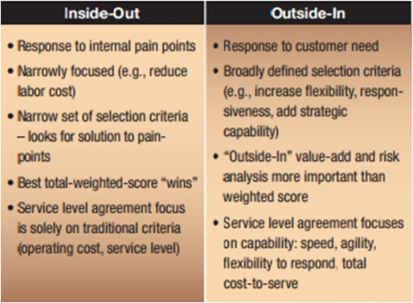Strategic Outsourcing: It’s Time for an “Outside-In” Approach
Today, every large corporation has more than one supply chain, disruptions threaten the flow of goods and services at every hand-off, and social networks can radically change “perfect” demand plans at internet speed. As such, we believe it’s time for an expanded set of decision-making tools and a fundamentally different mindset to build a true strategic outsourcing strategy, from the initial outsourcing decision to the final supplier selection and service level agreement (SLA).
Walking into your office early Monday morning, you hope that the weekend fire-drill–expediting late shipments to your #1 customer– was successful. As the executive in charge of a global, Consumer Products supply chain, you trust that your team and your outsourcing partner were able to make the right decisions and get the job done. However, once you open your email, you quickly realize it is going to be a very long day. A flood of internal and external “blame game” messages is all that has taken place, and not a single shipment has left the dock. You say to yourself: “Something is just not right –there has to be a better way.” We’ve all heard about the benefits of outsourcing:
- increased profitability,
- improved flexibility, and
- the ability to add value beyond one’s own capabilities.
On the other hand, the all-too common scenario above reminds us that in spite of best intentions (and more than enough lessons learned), when it comes to successful partnerships and true collaboration, these efforts continue to miss the mark. A decade’s worth of supply chain experience suggests that the decision-making processes and tools that once served so well may now be a key contributing factor to these negative outcomes. That is, they were developed during a time when global supply chains were the exception, not the norm, when risk could be actually managed, and the likelihood of ROI for a given investment could be reasonably predicted.
Today, every large corporation has more than one supply chain, disruptions threaten the flow of goods and services at every hand-off, and social networks can radically change “perfect” demand plans at internet speed. As such, we believe it’s time for an expanded set of decision-making tools and a fundamentally different mindset, from the initial outsourcing decision to the final supplier selection and service level agreement (SLA). The approach we suggest is not new; however, its application is. In our view, it’s time for an “outside-in” approach.
What is the Outside-In Approach for Strategic Outsourcing?
One way of defining “outside-in” is to contrast it with “inside out.” Today’s “inside-out” outsourcing processes and decision making tools often begin with “the problem.” They are initiated in response to existing pain points inside the company, and the supplier selection processes focus solely on those capabilities that will fix the pain and make the company “better.” On the other hand, an “outside-in” process begins and ends
with the customer. The decision is initiated in response to strategic needs that exist outside the company, and the decision-making process focuses on how it will enable an improved customer experience. A quick contrast follows:

Click through below to read the full study from Clarkston Consulting.


